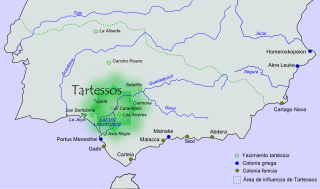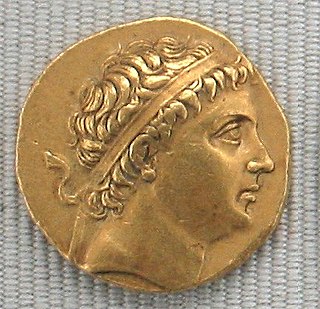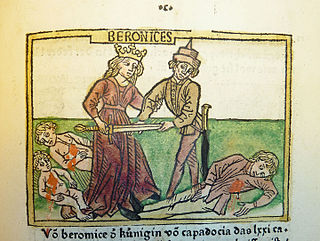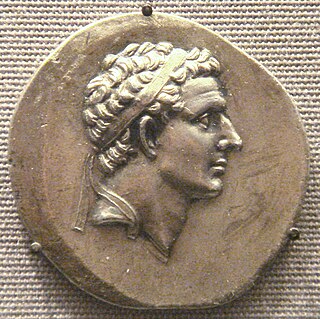Related Research Articles

In Greek mythology, the Trojan War was waged against the city of Troy by the Achaeans (Greeks) after Paris of Troy took Helen from her husband Menelaus, king of Sparta. The war is one of the most important events in Greek mythology and has been narrated through many works of Greek literature, most notably Homer's Iliad. The core of the Iliad describes a period of four days and two nights in the tenth year of the decade-long siege of Troy; the Odyssey describes the journey home of Odysseus, one of the war's heroes. Other parts of the war are described in a cycle of epic poems, which have survived through fragments. Episodes from the war provided material for Greek tragedy and other works of Greek literature, and for Roman poets including Virgil and Ovid.

Tartessos or Tartessus, was a semi-mythical harbor city and the surrounding culture on the south coast of the Iberian Peninsula, at the mouth of the Guadalquivir River. It appears in sources from Greece and the Near East starting during the first millennium BC. Herodotus, for example, describes it as beyond the Pillars of Heracles. Roman authors tend to echo the earlier Greek sources but from around the end of the millennium there are indications that the name Tartessos had fallen out of use and the city may have been lost to flooding, though several authors attempt to identify it with cities of other names in the area. Archaeological discoveries in the region have built up a picture of a more widespread culture, identified as Tartessian, that includes some 97 inscriptions in a Tartessian language.

Dido, also known as Elyssa, was the legendary founder and first queen of the Phoenician city-state of Carthage, located in modern Tunisia. Known only through ancient Greek and Roman sources, most of which were written well after Carthage's founding, her historicity remains uncertain. In most accounts, she was the queen of the Phoenician city-state of Tyre who fled tyranny to found her own city in northwest Africa.

Diodotus I Soter, was the first Greek king of Bactria. Diodotus became independent of the Seleucid empire around 255 or 245 BC, and established the Diodotid Bactrian Kingdom, which endured in various forms until the beginning of the first century AD. In around 250 BC Diodotus repelled a Parthian invasion of Bactria by Arsaces, but little is known about this war, except that it resulted in a peace treaty, favourable to Diodotus, and a possible alliance was formed. He also minted an extensive coinage and administered a powerful and prosperous new kingdom. He died around 235 BC of likely natural causes and was succeeded by his son, Diodotus II.

Alexander II Theos Epiphanes Nikephoros was a Hellenistic Seleucid monarch who reigned as the King of Syria between 128 BC and 123 BC. His true parentage is debated; depending on which ancient historian, he either claimed to be a son of Alexander I or an adopted son of Antiochus VII. Most ancient historians and the modern academic consensus maintain that Alexander II's claim to be a Seleucid was false. His surname "Zabinas" (Ζαβίνας) is a Semitic name that is usually translated as "the bought one". It is possible, however, that Alexander II was a natural son of Alexander I, as the surname can also mean "bought from the god". The iconography of Alexander II's coinage indicates he based his claims to the throne on his descent from Antiochus IV, the father of Alexander I.

Pharnaces II of Pontus was the king of the Bosporan Kingdom and Kingdom of Pontus until his death. He was a monarch of Persian and Greek ancestry. He was the youngest child born to King Mithridates VI of Pontus from his first wife, his sister Queen Laodice. He was born and raised in the Kingdom of Pontus and was the namesake of his late double great grandfather Pharnaces I of Pontus. After his father was defeated by the Romans in the Third Mithridatic War and died in 63 BC, the Romans annexed the western part of Pontus, merged it with the former Kingdom of Bithynia and formed the Roman province of Bithynia and Pontus. The eastern part of Pontus remained under the rule of Pharnaces as a client kingdom until his death.

Antigonus III Doson was king of Macedon from 229 BC to 221 BC. He was a member of the Antigonid dynasty.

Antequera is a city and municipality in the Comarca de Antequera, province of Málaga, part of the Spanish autonomous community of Andalusia. It is known as "the heart of Andalusia" because of its central location among Málaga, Granada, Córdoba, and Seville. The Antequera Dolmens Site is a UNESCO World Heritage site.

The Cynetes or Conii were one of the pre-Roman peoples of the Iberian Peninsula, living in today's Algarve and Lower Alentejo regions of southern Portugal, and the southern part of Badajoz and the northwestern portions of Córdoba and Ciudad Real provinces in Spain before the 6th century BCE. According to Justin's epitome, the mythical Gargoris and Habis were their founding kings.

Berenice III was also known as Cleopatra, ruled between 101 and 80 BC. Modern scholars studying Berenice III refer to her sometimes as Cleopatra Berenice. She was co-ruler of Ptolemaic Egypt from 101–88 BC and again in 81 BC, before reigning as sole monarch of Egypt from 81 to 80 BC.

Berenice or Laodice of Cappadocia, also known as Laodice was a princess from the Kingdom of Pontus and a queen of the Kingdom of Cappadocia by marriage to Ariarathes VI, and queen of Bithynia by marriage to Nicomedes III. She was regent of Cappadocia in 116 during the minority of her son Ariarathes VII.

Orophernes Nicephorus was one of the two sons Antiochis pretended to have had with Ariarathes IV, the king of Cappadocia because she failed to have children. However, she then did bear a child, Mithridates, and told her husband about the fake sons. These were sent to Rome and Ionia respectively to avoid a succession dispute with the legitimate son, whose name was changed to Ariarathes and who succeeded his father as Ariarathes V in 163 BC. A few years later Orophernes deposed him with the help of Demetrius I Soter, who became the king of the Syria-based Seleucid Empire in 161 BC when he overthrew Antiochus V, an underage king, and his regent, Lysias. The reign of Orophernes was short-lived. The Romans restored Ariarathes V.

Ariarathes III, son of Ariaramnes, ruler of Cappadocia, and grandson of Ariarathes II, married Stratonice, a daughter of Antiochus II, king of the Seleucid Empire and wife Laodice I, and obtained a share in the government during the lifetime of his father. About 250 BC he was the first ruler of Cappadocia to proclaim himself king (basileus). It is known that he sided with Antiochus Hierax in his war against Seleucus II Callinicus. Ariarathes is also said to have expanded his kingdom adding Cataonia to his dominions. By his marriage he was the father of Ariarathes IV.

The Punic religion, Carthaginian religion, or Western Phoenician religion in the western Mediterranean was a direct continuation of the Phoenician variety of the polytheistic ancient Canaanite religion. However, significant local differences developed over the centuries following the foundation of Carthage and other Punic communities elsewhere in North Africa, southern Spain, Sardinia, western Sicily, and Malta from the ninth century BC onward. After the conquest of these regions by the Roman empire in the third and second centuries BCE, Punic religious practices continued, surviving until the fourth century CE in some cases. As with most cultures of the ancient Mediterranean, Punic religion suffused their society and there was no stark distinction between religious and secular spheres. Sources on Punic religion are poor. There are no surviving literary sources and Punic religion is primarily reconstructed from inscriptions and archaeological evidence. An important sacred space in Punic religion appears to have been the large open air sanctuaries known as tophets in modern scholarship, in which urns containing the cremated bones of infants and animals were buried. There is a long-running scholarly debate about whether child sacrifice occurred at these locations, as suggested by Greco-Roman and biblical sources.
Khema was a Buddhist bhikkhuni, or nun, who was one of the top female disciples of the Buddha. She is considered the first of the Buddha's two chief female disciples, along with Uppalavanna. Khema was born into the royal family of the ancient Kingdom of Madra, and was the wife of King Bimbisara of the ancient Indian kingdom of Magadha. Khema was convinced to visit the Buddha by her husband, who hired poets to sing about the beauty of the monastery he was staying at to her. She attained enlightenment as a laywoman while listening to one of the Buddha's sermons, considered a rare feat in Buddhist texts. Following her attainment, Khema entered the monastic life under the Buddha as a bhikkhuni. According to Buddhist tradition, the Buddha declared her his female disciple foremost in wisdom. Her male counterpart was Sariputta.
Socrates Chrestus was the second son of Nicomedes III of Bithynia. He usurped the Bithynian throne by deposing his elder brother or half brother, Nicomedes IV of Bithynia.
Miguel Romero García, better known as Miguel Romero Esteo, was a Spanish writer and university professor, whose work is part of Spanish post-war theatre movement.

Epítome de la conquista del Nuevo Reino de Granada is a document of uncertain authorship, possibly (partly) written by Spanish conquistador Gonzalo Jiménez de Quesada between 1548 and 1559. The book was not published until 1889 by anthropologist Marcos Jiménez de la Espada in his work Juan de Castellanos y su Historia del Nuevo Reino de Granada.
Fatima bint Muhammad bint al-Ahmar was a Nasrid princess of the Emirate of Granada, the last Muslim state on the Iberian Peninsula. A daughter of Sultan Muhammad II and an expert in the study of barnamaj, she married her father's cousin and trusted ally, Abu Said Faraj. Their son Ismail I became sultan after deposing her half-brother, Nasr. She was involved in the government of her son but was especially politically active during the rule of her grandsons, Muhammad IV and Yusuf I, both of whom ascended the throne at a young age and were placed under her tutelage. Later Granadan historian Ibn al-Khatib wrote an elegy for her death stating that "She was alone, surpassing the women of her time / like the Night of Power surpasses all the other nights". Modern historian María Jesús Rubiera Mata compared her role to that of María de Molina, her contemporary who became regent to Castilian kings. Professor Brian A. Catlos attributed the survival of the dynasty, and eventual success, as being partly due to her "vision and constancy."
Gargoris was a mythical king of the Cynetes, considered part of the people of Tartessos, and, according to legend, the inventor of beekeeping.
References
- ↑ Hérnuñez, Pollux. Mitos, héroes y monstruos de la España antigua. Amaya.
- ↑ José Castro (translation) (1995). Epítome de las Historias Filípicas de Pompeyo Trogo. Fragmentos, Justin . Madrid: Gredos.
- ↑ "El Faro de Málaga -Noticias de Málaga y provincia-".